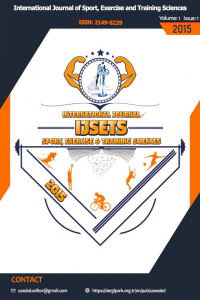Effect of BMI on Fundamental Motor Skill Proficiency Among 9 to 10 years-old Turkish Children
Effect of BMI on Fundamental Motor Skill Proficiency Among 9 to 10 years-old Turkish Children
Aim: To examine the effect of body mass index (BMI) on Fundamental Motor Skill Proficiency among 9 to 10 years-old Turkish children.
Keywords:
Motor Skill Proficiency, BMI 9-10 years-old, children,
___
- Boz, M. & Gungor Aytar, A. (2012). The Effect of Fundamental Movement Education on Pre-school Children’s Movement Skills. Hacettepe University Journal of Education, Special Issue 1: 51-59.
- Catenassi, F, Marques, Z.I., Bastos, C.B., Basso, L., Vaz Ronque, E.R. & Gerage, A.M. (2007). Relationship between body mass index and gross motor skill in four to six-year-old children. Rev Bras Med Esporte, 13(4), 203-206. DOİ: 10.1590/S1517-86922007000400003.
- CDC. (2019). BMI Percentile Calculator for Child and Teen, 2019. Retrieved from https://www.cdc.gov/healthyweight/bmi/calculator.html on 20 October 2019.
- Cliff, D.P., Okely, A.D., Morgan, P.J., Jones, R.A., Steele, J.R. & Baur, L.A. (2012). Proficiency deficiency: Mastery of fundamental movement skills and skill components in overweight and obese children. Obesity, 20, 1024–33. DOI: 10.3109/17477166.2011.575154.
- D’hondt, E., Deforche, B., Bourdeaudhuij, I.D. & Lenoir, M. (2009). Relationship Between Motor Skill and Body Mass Index in 5- to 10-Year-Old Children. Adapted Physical Activity Quarterly, 26, 21-37. DOI: 10.1123/apaq.26.1.21.
- Ersoz, Y. (2012). Effect of Multi-Skill Sport Education on Motor Development of Boys aged 7 to 10. Unpublished Sport Physiology Master’s Thesis, Izmir, Turkey, Dokuz Eylül University.
- Gallahue, D.I., Ozmun, J.C. & Goodway, J.D. (2012). Understanding Motor Development: Infants, Children, Adolescents, Adults Motor (7th ed.). Boston, MA: McGraw-Hill.
- Guven, O. & Yildiz, O. (2014). Expectations of the Classroom Teachers from Play and Physical Activities Lesson. Kastamonu Education Journal, 22 (2), 525-538.
- Lin, S-J. & Yang, S-C. (2015). The Development of Fundamental Movement Skills by Children Aged Six to Nine. Universal Journal of Educational Research, 2015; 3(12): 1024-1027, DOI: 10.13189/ujer.2015.031211.
- Lopes, V.P., Stodden. D.F., Bianchi. M.M., Maia. J.A. & Rodrigues. L.P. (2012). Correlation between BMI and motor coordination in children. Journal of Science and Medicine in Sport, 2012; 15, 38–43. DOI: 10.1016/j.jsams.2011.07.005.
- Marmeleira, J., Veiga. G., Cansado. H. & Raimundo. A. (2017). Relationship between motor proficiency and body composition in 6- to 10-year-old children. Journal of Pediatrics and Child Health, 53, 348–353. DOI:10.1111/jpc.13446.
- Nobre, G.C., Bandeira, P.F.R. & Valentini, N.C. (2016). The Relationship Between General Perceived Motor Competence, Perceived Competence Relative to Motor Skill and Actual Motor Competence in Children. Journal of Physical Education, 27, e2744. DOI: 10.4025/jphyseduc.v27i1.2744.
- OECD Obesity Update (2016). Retrieved from https://www.oecd.org/health/obesity-update.htm on 20 October 2020.
- Poulsen, A.A., Desha, L., Ziviani, J., Griffiths, L., Heaslop, A., Khan, A. & Leong, G.M. (2011). Fundamental movement skills and self-concept of children who are overweight. International Journal of Pediatric Obesity, 6, e464–71. DOI: 10.3109/17477166.2011.575143.
- Ré, A.H.N., Logan, S.W., Cattuzzo, M.T., Henrique, R.S., Tudela, M.C. & Stodden, D.F. (2018). Comparison of motor competence levels on two assessments across childhood. Journal of Sports Sciences, 36:1, 1-6, DOI:10.1080/02640414.2016.1276294.
- Saygın, Ö., & Ceylan, H. İ. (2017). A Comparison of body mass index and daily step numbers of secondary school and high school students according to age and gender. Int J Sport Exer & Train Sci, 3 (4), 142-152. DOI: 10.18826/useeabd.337683
- Southall, J., Okely, A. & Steele, J. (2004). Actual and perceived physical competence in overweight and non-overweight children. Pediatric Exercise Science, 16, 15 – 24. DOI: 10.1123/pes.16.1.15.
- Stodden, D.F., Goodway, J.D., Langendorfer, S.J., Roberton, M.A., Rudisill, M.E., Garcia, C. & Garcia, L.E. (2008). A developmental perspective on the role of motor skill competence in physical activity: An emergent relationship. Quest, 60(2), 290–306. DOI: 10.1080/00336297.2008.10483582.
- The Preschool Curriculum. (2019). Ministry of Education, Ankara, Turkey, 2013. Retrieved from https://tegm.meb.gov.tr/dosya/okuloncesi/ooproram.pdf on 20 October 2019.
- Turkey Nutrition and Health Research. (2014). Ministry of Health, Ankara, Turkey, 2014. Hyperlink: [https://hsgm.saglik.gov.tr/depo/birimler/saglikli-beslenme-hareketli-hayat-db/Yayinlar/kitaplar/diger-kitaplar/TBSA-Beslenme-Yayini.pdf]. Retrieved on 14 January 2020.
- Ulrich, D. (2000). Test of gross motor development: second edition Austin, TX: PRO-ED.
- Ulutas, A., Demir, E. & Yayan, E.H. (2017). Effect of Motor Development Program on Rough and Fine Motor Development of Five-Six-Year-Old Children. Abant İzzet Baysal University Education Faculty Journal, 17 (3), 1523-1538.
- Wearing, S.C., Hennig, E.M., Byrne, N.M., Steele, J.R. & Hills, A.P. (2006). The impact of childhood obesity on musculoskeletal form. Obesity Reviews, 7: 209–18. DOİ:10.1111/j.1467-789X.2006.00216.x.
- Whitehead, M. (2010). Physical literacy: Throughout the life course, Oxon, MD: Routledge.
- WHO. (2019). Global Recommendations on Physical Activity for Health, 5–17 years old, USA, 2011. Retrieved from https://www.who.int/dietphysicalactivity/factsheet_young_people/en/
- ISSN: 2149-8229
- Başlangıç: 2015
- Yayıncı: İbrahim ERDEMİR
